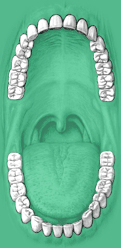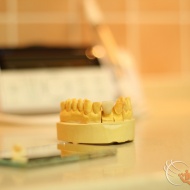During making aesthetic fillings first we have to treat the tooth material’s surface. To do this, usually the doctor uses orthophosphoric, then a special adhesive, which establishing a connection between the filling material and the tooth’s material. Some newly developed adhesives can supply these two steps alone. The majority of such filling materials and adhesives are bond to the high-energy blue (near wavelength to the UV region, but not UV) light.
The foregoing shows that the preparation of a composite filling is a complex, multistep process; therefore it is very sensitive to the applied technology, and to the moisture before lighting. For achieving long-term durability the dentist should make the composite filling in absolutely dry environment. If the clean, dry environment meets with the good quality material, stronger bond can be achieved in the border of the filling and the tooth, as in many spaces among the tooth’s particles. This is demonstrated better, that from a good quality composite with so called adhesive method constructed tooth’s force effect is never break along the filling, but somewhere in the border of the enamel and dentine's component tooth base substance. But, we have to know that the composites’ quality moves in a very wide range as well as their prices. The gram of composite ranges between 1 000 Huf and 20 000 Huf (depends on the quality), therefore do not expect much from such a filling, which the dentist prepares from a few thousand Forints. If we would like to pay not much, we make better if we choose amalgam filling.
We changed metal filling to aesthetic composite filling, in which we assume 10 years guarantee:

Read more about the technology:
The aesthetic restorations got into the trade in 1960 were. Their spread has allowed the elimination of amalgam - as less aesthetic restorative materials - from the treatment of dental caries. The filler provides the reinforcement and abrasion resistance of soft ground substance. The fillings are available in various colors, from which the dentist determines with the help of shade guide the right one for you. The large range of colors allows forming the perfect shade, because we get into the cavity the different shades by layers. Downmost will get the core material like the color of the dentin, then outwards follow the transparent layers. On the top so called enamel color will be put on which apes the sparkle and transparency of enamel. This layered filling technique allows the preparation of color matching filling with the original tooth.
Usage of composition fillings:
- veneering of faded surfaces
- correction of enamel defects
- for metal allergy patients ‘care
Steps of making fillings:
The intervention happens under local anesthesia in all cases, so it is painless. The first step is checking the vitality of the tooth. We study, if the tooth is intact and sentient or not. During the examination we usually used cold stimuli; in this case we touch volatile liquid (chloroethyl) to the surface of the tooth. If you feel that a cold stimulus is created, it is the clear sign of the vitality of the pulp. Otherwise, further studies are needed (eg. x-ray).
Before the injection of the local anesthetic, the dentist will numb the surrounding area of the tooth with a flavored numbing gel. Thus the anesthetic injection is completely painless, and from that time you won’t feel anything. We remove the decayed part by using special drills. In order to create a perfectly caries-free cavity, we use so called caries indicator. It is a bright colored solution, which is transferred to the cavity with a cotton piece, which dyes the decayed parts. With its usage we can be sure that each of decayed tissue debris was removed. After the cavity is formed, separate (isolate) the area with cotton rolls or saliva compartment (rubber dam isolation) and determine the matching tooth color with your teeth as well. After the isolation we are conditioning the enamel with a special the gel-like material. The conditioning is increase the needed fixation surface for the filling material. We bond the conditioned surfaces. The bond is such an adhesive material which fixes the filling material to the tooth’s tissues - enamel, dentine. We lighten the bond with polymerization lamp which is essential for the binding of material. This is followed by the allocation of the filling material into the cavity. This happens by each layer with the appropriate color of material. Each layer is lightening separately. Finally we prepare the anatomical shape of the tooth, the cusps and fissures. The illumination happens with polymerization lamp. Its aim is the bonding of the filling material. As a final step we carry out the bite test which shows whether the filling has adequate height or not. After we created the right height, we are polishing the surface of filling. This increases the strength of the surface layer, and provides a perfectly smooth surface in order to reduce the likelihood of the adhesion of plaque. Polishing is similar to enamel radiance to the surface, and also improve the filling’s edge closure, thus reducing the chances of developing secondary caries.




